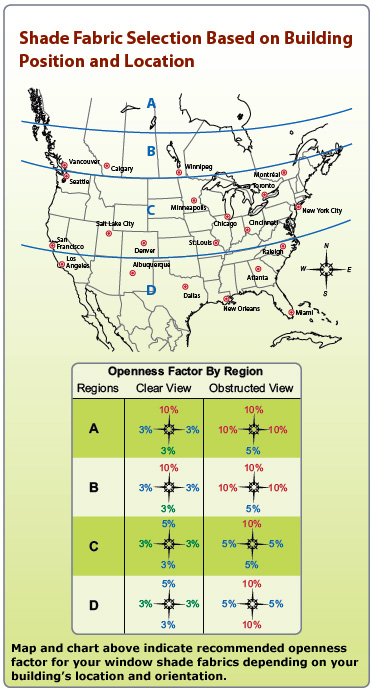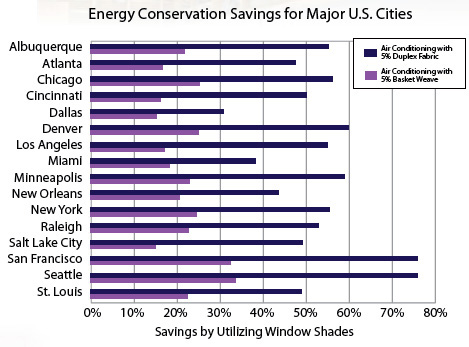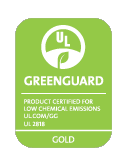Openness & Fenestration
- Fabric Openness Factor
- Fenestration Data
- Energy Conservation
- GreenGuard® Certification
- Microban® Protection

The key identifies four properties of shade fabrics and openness factors. Normally, dark colors provide better glare control because they absorb light. Light colors offer better heat control because they reflect heat. Duplex fabrics offer both glare control and heat control. Complete fabric lines and fire retardant ratings available by selecting “View All Fabrics” in the menu.
Natural light can be beneficial to health in the working environment. Ensuring protection against glare and reflection is essential when choosing window shade fabric openness. Openness selection should be based on building position, geographical location or exposure area, office activity, and view: clear or obstructed.
See the map for recommendations for window shade openness factor to control glare and work station reflections, for UV protection and for better view-through capabilities.
Draper offers test data for the specifiers’ use in controlling light and heat, view and privacy, and glare level.
- Solar transmittance (TS), reflectance (RS), and absorbance (AS) add up to 100%, indicating that all the sun’s energy striking the shade is reflected, absorbed, or passed through.
- Visible transmittance (TV) indicates the amount of glare likely to be perceived.
- Openness factor (OF) concerns the density of the weave.
- Shading coefficients (SC) indicate shading efficiency.
Fenestration data is available for each fabric through our Fabric Selector Tool.
 The chart illustrates energy conservation for identical buildings located in each of the major U.S. cities listed for one full year, when compared to no window shades. As you can see, utilizing appropriate solar shading can save from approximately 15% to 75% on cooling costs depending on the location and climate, and on what fabric is chosen. This simulation was performed with several constants:
The chart illustrates energy conservation for identical buildings located in each of the major U.S. cities listed for one full year, when compared to no window shades. As you can see, utilizing appropriate solar shading can save from approximately 15% to 75% on cooling costs depending on the location and climate, and on what fabric is chosen. This simulation was performed with several constants:
- Fabric: 5% Basketweave fabric is a charcoal color. 5% Duplex fabric is charcoal/white color.
- Solar shading: The horizon is presumed to be at a vertical level of 5°. No other obstacles or buildings are taken into account.
- Glazed surface in facade(s): 50% of the facade total surface. U-value of glazing: 2.9 W/m²K (i.e. 0.15˝ or 4 mm glass).
- This information refers to interior shades only.
 GreenGuard Certification is valuable for architects, designers, product specifiers, and purchasers who want to locate, specify, and purchase low emitting products for indoor environments. GREENGUARD® Children & Schools™ certified materials meet or exceed the strictest standards for indoor air quality where children spend many hours a day.
GreenGuard Certification is valuable for architects, designers, product specifiers, and purchasers who want to locate, specify, and purchase low emitting products for indoor environments. GREENGUARD® Children & Schools™ certified materials meet or exceed the strictest standards for indoor air quality where children spend many hours a day.
Draper GreenGuard® certified fabrics can be viewed through our Fabric Selector Tool.
![]() Microban antimicrobial protection works continually to inhibit the growth of stain-causing bacteria, mold and mildew for the life of the shade. To see which of our fabrics have Microban certifications, filter using our Fabric Selector Tool.
Microban antimicrobial protection works continually to inhibit the growth of stain-causing bacteria, mold and mildew for the life of the shade. To see which of our fabrics have Microban certifications, filter using our Fabric Selector Tool.
